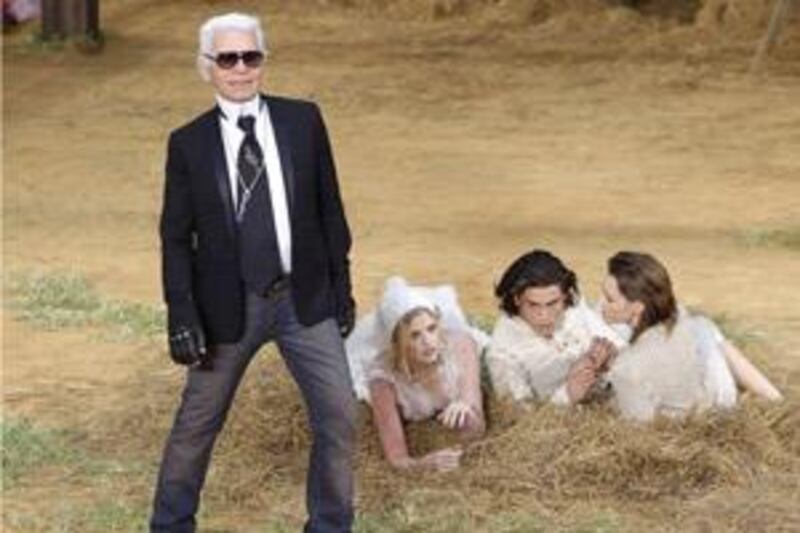How is it that, at the grand old age of 76, Karl Lagerfeld is the one designer who can bring an audience of cynical, hard-bitten, show-fatigued fashionistas to their feet, cheering, as he delivers for Chanel not just a fabulous catwalk set, not just a beautiful collection, not just Prince in the audience, but also a live performance by a sparkly-costumed Lily Allen and her band? Will the man ever fail to surprise us? Let's hope not, because if there are more shows like Tuesday's extravaganza to come we definitely want to see them.
The theme for the Chanel show was a riff on the pastoral idyll, its starting point the country hamlet that Marie Antoinette had built in the grounds of Versailles to escape the stuffy royal court. Thus a 14-tonne barn was constructed in the traditional Chanel venue, the Grand Palais, bearing 150 metres of field flower garlands, the whole thing taking more than a month and a half to complete. The models wandered through the structure, just as the doomed queen's courtiers might innocently have done, to the baroque grind of Michael Nyman's score for The Draughtsman's Contract, and it seemed that a regally rococo collection was to be the day's work, until the stately soundtrack was abruptly mixed with Primal Scream's Get Your Rocks Off. The stage was set for the French aristocracy to meet rock 'n' roll, with a series of eggshell-pale trademark suits in mini-lengths, matched with high clogs, cross-garters and destroyed updos. Tweeds were frayed and appliquéd with faux-naive ribbon work; skirts and jackets were knitted in elaborate but chunky knotted and cable stitches, with colourful knitted flowers scattered across them; and skirts were suitably crinoline-like, springing out from beneath slender cardigans. Primal Scream moved on to Justified and Ancient by The KLF (the early Nineties group best known for burning £1 million of their own money in an artistic statement) featuring Tammy Wynette, which took the country theme in a western direction, allowing Lagerfeld to indulge in the very un-Chanel silhouettes of puffed-up and leg-of-mutton sleeves.
For evening, a more Napoleonic empire line appeared in black and white, with a classical one-shoulder bodice, and those mini-crinis kept on coming, now with fresh country checks, delicate Leavers lace shawls or ethereal sea-coloured tulle. But the biggest surprise of all was saved till the end, when the floor of the catwalk began to elevate and up popped a platform bearing the British songstress Allen, in a fabulous black-and-white sequinned dress with matching shoes, who treated us to her song It's Not Fair. The crowd went wild, delighted that, as other designers take smaller venues and present less extravagant shows, Karl had kept the party stomping.
It was certainly a sign of confidence in a difficult time, but as Bruno Pavlovsky, the chairman of fashion at Chanel, pointed out to me beforehand, the show is not just about presenting clothes: it's about the venerable brand's identity. "Recession or no recession, we are very consistent with the DNA of the brand," he said. "It's more than a show. The collection, the clothes are very important, the accessories are very important, but on top of that the ambience, the decor... it's a full story about the brand. And you can feel all the DNA of the brand through this kind of event. That's why for us it's very important to be able to set up such events."
It was certainly a far cry from the Chloé collection, by Hannah MacGibbon, which continued in the pleasant but unremarkable tradition of the brand with a series of crisp, masculine suits, coats and ponchos, with a couple of very pretty dresses at the end. Valentino's show, meanwhile, under the auspices of the design duo Maria Grazia Chiuri and Pier Paolo Piccioli, had almost the opposite approach to Lagerfeld at Chanel, virtually abandoning many of the tenets of the classic Valentino style. Yet in its place was an exquisitely pretty collection of silvery gowns replete with floating ruffles, shimmering gazar silks and rippling frills.
But the day ended as it had begun, with a spectacle from one of fashion's certifiable geniuses: Alexander McQueen. Like Lagerfeld, he never fails to thrill the audience with a narrative that grips the imagination, and this time McQueen, whose show was simultaneously broadcast live on the internet, managed to cram 400 million years of evolution (give or take a few millennia) into one extraordinary collection. At the start, his beautifully conceived and constructed dresses - armoured bodices and full, structured skirts - bore vividly symmetrical prints derived from amphibians, fish and reptiles. By the end, the models were super-advanced space-dwelling beings, all cold, silvery iridescence and emotionless faces. Like nothing else this season - or indeed any other season - McQueen's collection followed its own path. A day bookended by the ancient and the justified, and characterised by money to be well spent, not merely burnt.





